Rabbit Transit
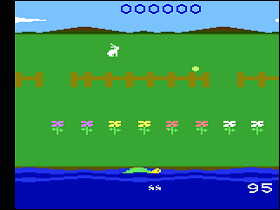 The Game: Oh, it’s just a harmless little bunny, isn’t it? But this bunny needs some help to navigate a garden crawling with other critters to reach his ride to find his family (in this case, on the back of a turtle). The turtle takes the bunny to a series of platforms. The bunny needs to change the color of every platform – and avoid projectiles being dropped from above – to rescue his fellow bunnies. Once the platform level has been beaten and more bunnies have been led home, the garden level begins again with increased difficulty. (Starpath, 1983)
The Game: Oh, it’s just a harmless little bunny, isn’t it? But this bunny needs some help to navigate a garden crawling with other critters to reach his ride to find his family (in this case, on the back of a turtle). The turtle takes the bunny to a series of platforms. The bunny needs to change the color of every platform – and avoid projectiles being dropped from above – to rescue his fellow bunnies. Once the platform level has been beaten and more bunnies have been led home, the garden level begins again with increased difficulty. (Starpath, 1983)
Memories: No one can deny that Starpath‘s games for the Supercharger add-on were often on a whole different level than the average third-party game (i.e. much of what wasn’t released by the clearly above-average Activision and Imagic). But it’s also hard to deny that Starpath, for some reason, chose to show those capabilities off with game concepts that were derivative.
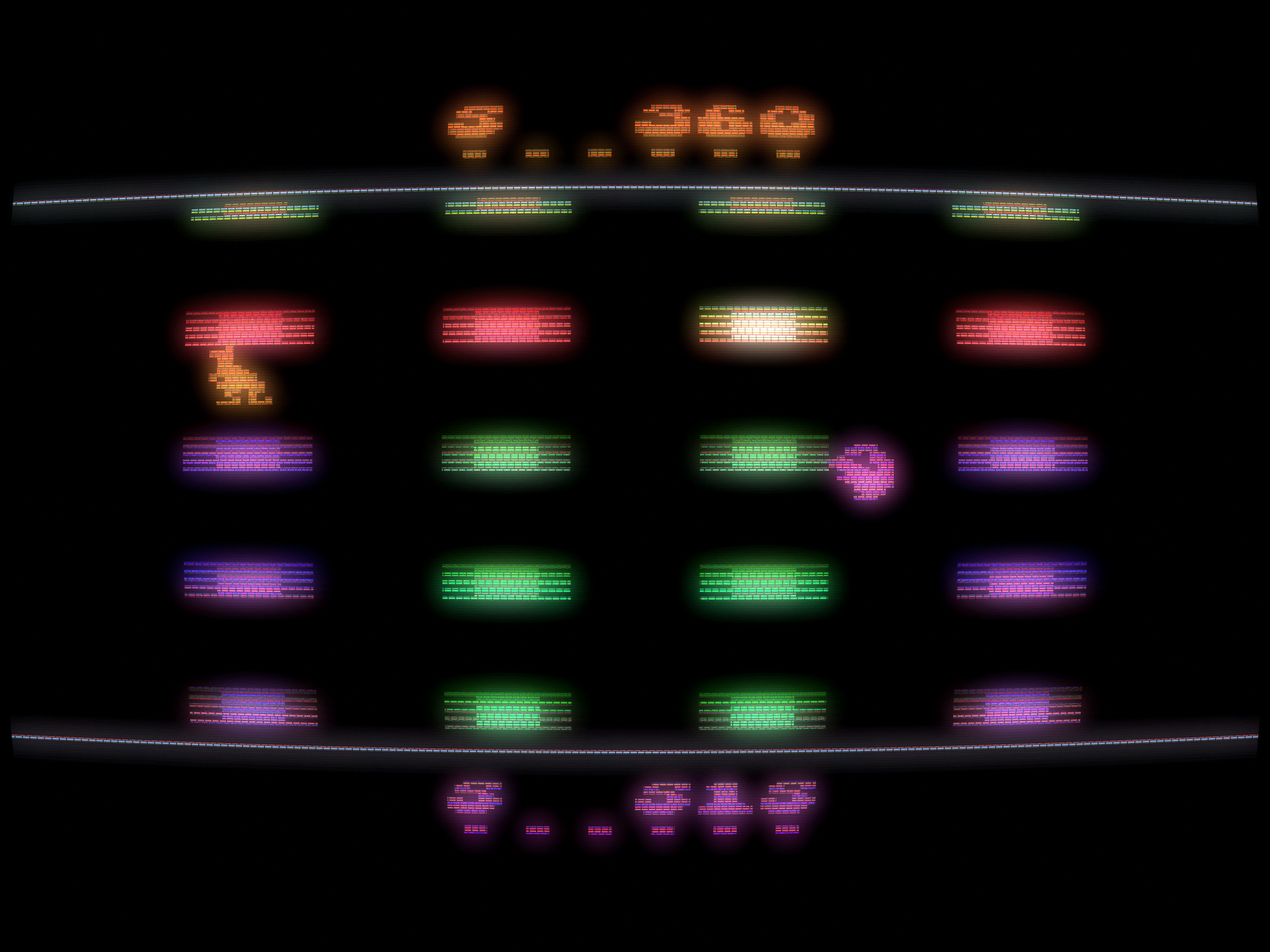
Quick Step
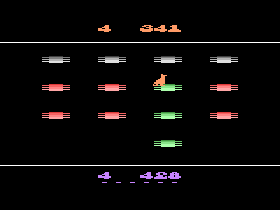 The Game: In what one can only assume is a long-standing rivalry spawned at your local zoo, a kangaroo and a squirrel battle it out on a relentlessly scrolling playing field of multicolored magic flying carpets. The player’s kangaroo tries to change as many of those carpets to his color (green) by hopping on them, while the squirrel (controlled either by the computer or by a second player) will try to turn those carpets blue. Allowing your critter to scroll off the bottom of the screen will cost you one of his lives, and the game ends when one critter or the other has run out of them. (Imagic, 1983)
The Game: In what one can only assume is a long-standing rivalry spawned at your local zoo, a kangaroo and a squirrel battle it out on a relentlessly scrolling playing field of multicolored magic flying carpets. The player’s kangaroo tries to change as many of those carpets to his color (green) by hopping on them, while the squirrel (controlled either by the computer or by a second player) will try to turn those carpets blue. Allowing your critter to scroll off the bottom of the screen will cost you one of his lives, and the game ends when one critter or the other has run out of them. (Imagic, 1983)
Memories: In the early days of third-party games for the 2600, game manufacturers were happy to just mimic what was in the arcades – Activision‘s early hit Kaboom! directly copied an early arcade game called Avalanche, Imagic‘s Atlantis (which borrowed heavily from the obscure Taito coin-op Colony 7), and countless Pac-Man clones (Alien, Shark Attack, and so on). Even Atari got in on the act, porting Exidy‘s Circus to the VCS as Circus Atari. But after Atari sued the Odyssey2 game K.C. Munchkin! off the shelves, however, you’d think the rules would’ve changed, and the third-party developers would have found that ever-present legal threat encouragement enough to pursue more innovative ideas.
Q*Bert
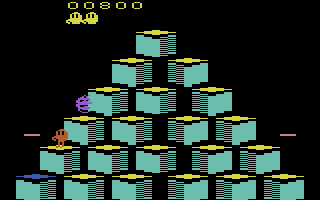 The Game: Q*Bert, a nosey little guy with a propensity for hopping, spends his time hopping around a three-dimensional pyramid of cubes, avoiding Coily the Snake and other assorted purple and red creatures, including a few who operate on a slightly different plane (i.e., they move down the pyramid as if it were rotated one-third). Any green objects and creatures Q*Bert can catch will not hurt him – in fact, the little bouncing green balls will stop time briefly for everyone but Q*Bert. If he gets into a tight spot, Q*Bert can jump off the pyramid onto a flying disc which will deposit him back at the top of the pyramid – and lure Coily to a nasty fate by jumping into nothing. Changing the colors of the top of every cube in the pyramid to the target color indicated at the top left of the screen will clear the pyramid and start the craziness all over again. If Q*Bert is hit by an enemy or falls off the pyramid, he hits bottom with a burst of incomprehensible obscenity! (Parker Brothers, 1983)
The Game: Q*Bert, a nosey little guy with a propensity for hopping, spends his time hopping around a three-dimensional pyramid of cubes, avoiding Coily the Snake and other assorted purple and red creatures, including a few who operate on a slightly different plane (i.e., they move down the pyramid as if it were rotated one-third). Any green objects and creatures Q*Bert can catch will not hurt him – in fact, the little bouncing green balls will stop time briefly for everyone but Q*Bert. If he gets into a tight spot, Q*Bert can jump off the pyramid onto a flying disc which will deposit him back at the top of the pyramid – and lure Coily to a nasty fate by jumping into nothing. Changing the colors of the top of every cube in the pyramid to the target color indicated at the top left of the screen will clear the pyramid and start the craziness all over again. If Q*Bert is hit by an enemy or falls off the pyramid, he hits bottom with a burst of incomprehensible obscenity! (Parker Brothers, 1983)
Memories: This game has been much-maligned by some VCS owners over the years, which is something I take issue with. The 2600 translation of the famous arcade game was just fine! The graphics conveyed the pyramid of cubes just fine, it was easy to tell which way Q*Bert was headed, and overall I had no complaints. Even the sound effects, even though they were in some cases not even close to the distinctive sounds of the original, had their own strange charm.
Q*Bert
 The Game: Q*Bert, a nosey little guy with a propensity for hopping, spends his time hopping around a three-dimensional pyramid of cubes, avoiding Coily the Snake and other assorted purple and red creatures, including a few who operate on a slightly different plane (i.e., they move down the pyramid as if it were rotated one-third). Any green objects and creatures Q*Bert can catch will not hurt him – in fact, the little bouncing green balls will stop time briefly for everyone but Q*Bert. If he gets into a tight spot, Q*Bert can jump off the pyramid onto a flying disc which will despoit him back at the top of the pyramid – and lure Coily to a nasty fate by jumping into nothing. Changing the colors of the top of every cube in the pyramid to the target color indicated at the top left of the screen will clear the pyramid and start the craziness all over again. If Q*Bert is hit by an enemy or falls off the pyramid, he responds with a cartoon balloon full of mock profanity. (Parker Brothers, 1983)
The Game: Q*Bert, a nosey little guy with a propensity for hopping, spends his time hopping around a three-dimensional pyramid of cubes, avoiding Coily the Snake and other assorted purple and red creatures, including a few who operate on a slightly different plane (i.e., they move down the pyramid as if it were rotated one-third). Any green objects and creatures Q*Bert can catch will not hurt him – in fact, the little bouncing green balls will stop time briefly for everyone but Q*Bert. If he gets into a tight spot, Q*Bert can jump off the pyramid onto a flying disc which will despoit him back at the top of the pyramid – and lure Coily to a nasty fate by jumping into nothing. Changing the colors of the top of every cube in the pyramid to the target color indicated at the top left of the screen will clear the pyramid and start the craziness all over again. If Q*Bert is hit by an enemy or falls off the pyramid, he responds with a cartoon balloon full of mock profanity. (Parker Brothers, 1983)
Memories: Oof. If you thought this arcade classic suffered when crammed into an Atari 2600 cartridge… well, wait. Maybe’s that’s not a fair thing to say. The Intellivision version’s graphics were marginally better at best, and the sound was certainly better. But with the disc controllers, Q*Bert was almost unplayable.
Q*Bert
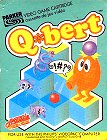 The Game: Q*Bert, a nosey little guy with a propensity for hopping, spends his time hopping around a pyramid of colorful blocks, avoiding Coily the Snake and other assorted purple and red creatures, including a few who operate on a slightly different plane (i.e., they move down the pyramid as if it were rotated one-third). Any green objects and creatures Q*Bert can catch will not hurt him – in fact, the little bouncing green balls will stop time briefly for everyone but Q*Bert. If he gets into a tight spot, Q*Bert can jump off the pyramid onto a flying disc which will deposit him back at the top of the pyramid – and lure Coily to a nasty fate by jumping into nothing. Changing the colors of the top of every block in the pyramid to the target color indicated at the top left of the screen will clear the pyramid and start the craziness all over again. (Parker Brothers, 1983)
The Game: Q*Bert, a nosey little guy with a propensity for hopping, spends his time hopping around a pyramid of colorful blocks, avoiding Coily the Snake and other assorted purple and red creatures, including a few who operate on a slightly different plane (i.e., they move down the pyramid as if it were rotated one-third). Any green objects and creatures Q*Bert can catch will not hurt him – in fact, the little bouncing green balls will stop time briefly for everyone but Q*Bert. If he gets into a tight spot, Q*Bert can jump off the pyramid onto a flying disc which will deposit him back at the top of the pyramid – and lure Coily to a nasty fate by jumping into nothing. Changing the colors of the top of every block in the pyramid to the target color indicated at the top left of the screen will clear the pyramid and start the craziness all over again. (Parker Brothers, 1983)
Memories: One of the last games ever produced for the Odyssey 2, this great adaptation of Q*Bert also has the distinction of being among the hardest to find. Released primarily in Europe for the Videopac (the Dutch-produced equivalent of the Odyssey2), Q*Bert has decent graphics and damned fast gameplay for an Odyssey game.
Pressure Cooker
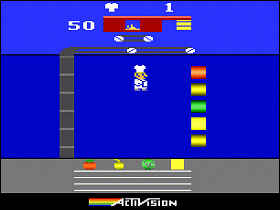
 The Game: The orders are flying fast and furious. The customers are waiting. The clock is ticking. And you’re the only short-order cook in the kitchen. Your job is simple: arrange a series of hamburgers with ingredients indicated by the symbols at the bottom of the screen. Don’t waste any condiments if you can help it, and whatever you do, don’t make a burger with toppings and condiments and then drop it into the wrong delivery chute. If you fill all the orders correctly in the time allotted, you might just get promoted to manager…but chances are, you’ll have to do it all again, only faster this time. (Activision, 1983)
The Game: The orders are flying fast and furious. The customers are waiting. The clock is ticking. And you’re the only short-order cook in the kitchen. Your job is simple: arrange a series of hamburgers with ingredients indicated by the symbols at the bottom of the screen. Don’t waste any condiments if you can help it, and whatever you do, don’t make a burger with toppings and condiments and then drop it into the wrong delivery chute. If you fill all the orders correctly in the time allotted, you might just get promoted to manager…but chances are, you’ll have to do it all again, only faster this time. (Activision, 1983)
Memories: This jewel of a game was the second Activision release for Garry Kitchen, who would later bring himself – and Activision – acclaim for a computer program called Game Maker. But for now, Kitchen had recently signed up, along with his brother, as the east coast branch of a company who – along with any other video game company that expected to stay in business – was decidedly located on the west coast. He already had a solid pedigree in the form of a slightly obscure shoot-’em-up, Space Jockey, published by Vidtec (later known as U.S. Games), and a little best-seller called Donkey Kong. He had also been one of the engineers responsible for the very popular miniature electronic pinball game, Wildfire.
Pole Position
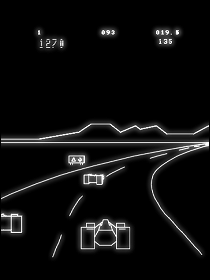 The Game: Prepare to qualify! Fly to the finish line in a fierce field of Formula One competitors in a qualifying lap. Leaving the track is trouble – and hitting one of the billboards dotted around the edges of the Mt. Fuji track is a sure way to miss out on the subsequent race. (GCE, 1983)
The Game: Prepare to qualify! Fly to the finish line in a fierce field of Formula One competitors in a qualifying lap. Leaving the track is trouble – and hitting one of the billboards dotted around the edges of the Mt. Fuji track is a sure way to miss out on the subsequent race. (GCE, 1983)
Memories: When GCE (and, briefly, the eager-to-get-into-the-video-game-business Milton Bradley) debuted the Vectrex, any argument that there was another system better-suited for home ports of arcade vector graphics games was over, period. With willing licensing partners like Cinematronics, Vectrex was a shoo-in. There’s only one problem: by 1983, vector graphics were rapidly falling out of wide use as more advanced raster graphics technology, driven by faster processors, came into play. What games would Vectrex play then?
Popeye
 The Game: Well, blow me down! Popeye the sailor man gets his own video game. On level one, you’re trying to catch Olive Oyl’s falling hearts before they descend to sea level and are lost, while ducking Bluto’s punches at the same time. A can of spinach appears every so often, giving you the opportunity to read the big bully the riot act (comic strip-style, of course). On level two, the falling hearts are replaced by falling musical notes, and you’ll need Wimpy’s hefty help to keep Swee’Pea from drifting away on a balloon. (Parker Brothers, 1983)
The Game: Well, blow me down! Popeye the sailor man gets his own video game. On level one, you’re trying to catch Olive Oyl’s falling hearts before they descend to sea level and are lost, while ducking Bluto’s punches at the same time. A can of spinach appears every so often, giving you the opportunity to read the big bully the riot act (comic strip-style, of course). On level two, the falling hearts are replaced by falling musical notes, and you’ll need Wimpy’s hefty help to keep Swee’Pea from drifting away on a balloon. (Parker Brothers, 1983)
Memories: Possibly the most faithful home version of Nintendo’s game about a certain sailor man there is, Popeye for the ColecoVision does this game proud.
Pole Position
 The Game: Prepare to qualify! Fly to the finish line in a fierce field of Formula One competitors in a qualifying lap. Leaving the track is trouble – and hitting one of the billboards dotted around the edges of the Mt. Fuji track is a sure way to miss out on the subsequent race. (Atari, 1983)
The Game: Prepare to qualify! Fly to the finish line in a fierce field of Formula One competitors in a qualifying lap. Leaving the track is trouble – and hitting one of the billboards dotted around the edges of the Mt. Fuji track is a sure way to miss out on the subsequent race. (Atari, 1983)
Memories: When Atari announced its home versions of Pole Position, its first-person racer licensed from Namco, there was rejoicing (for the 5200 version) and scoffing (for the 2600 version). As it turns out, both expectations may have been off the mark: the 2600 version was unexpectedly good for what it was, and by comparison the 5200 version seems at times as though it’s not all it could have been. Maybe the biggest surprise is that these two interpretations of the game weren’t wildly different.
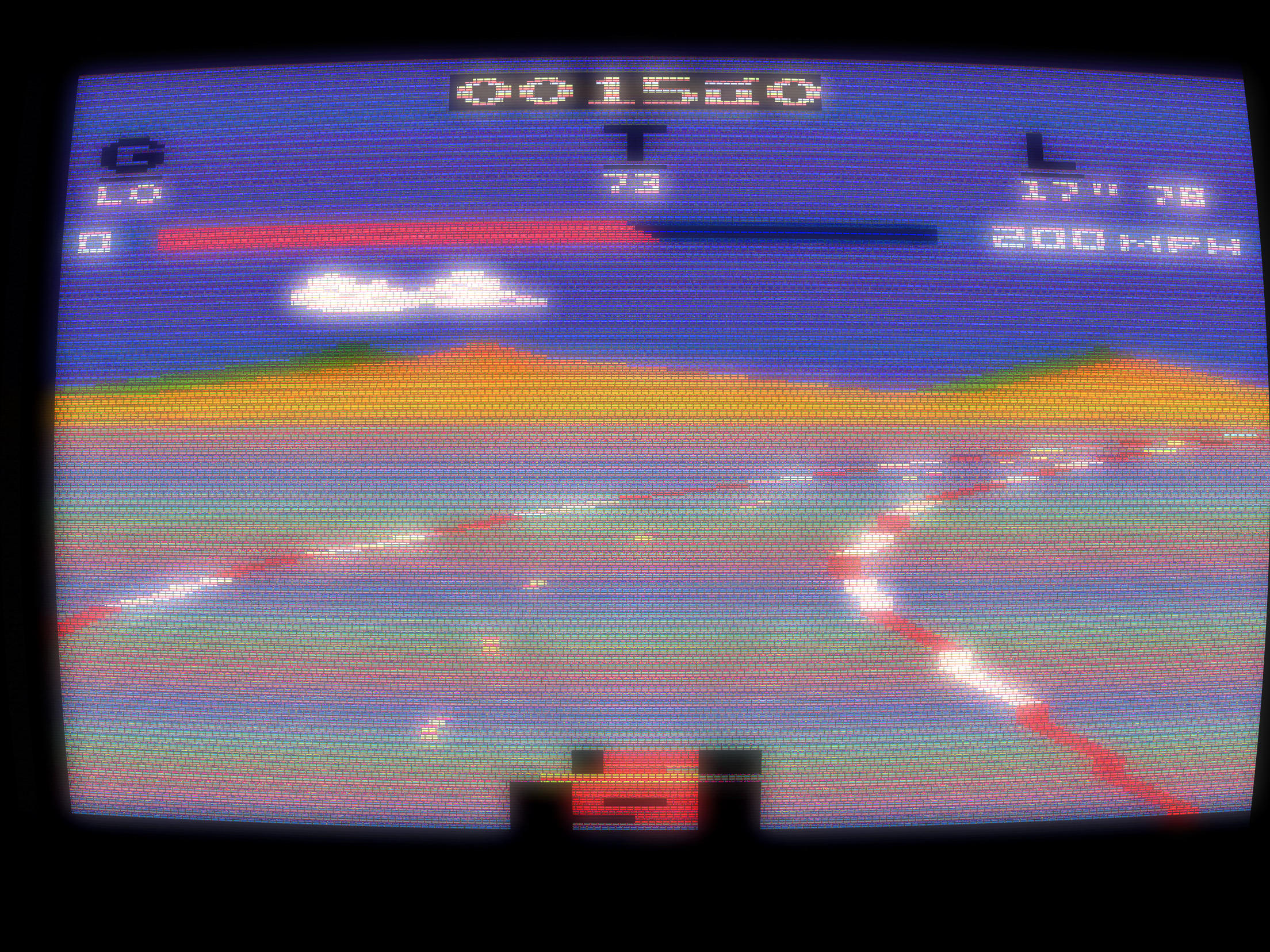
Pole Position
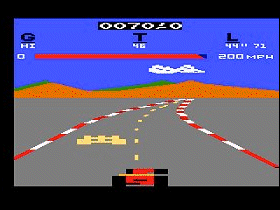 The Game: It’s your big chance to qualify for an unspecified big race at a track near Mt. Fuji in Japan. First, you try to get through the qualifying heat, racking up laps around the track as fast you can and accumulating as few wrecks as possible. If you pass muster, then you get to try it again with other cars on the track! (Atari, 1983)
The Game: It’s your big chance to qualify for an unspecified big race at a track near Mt. Fuji in Japan. First, you try to get through the qualifying heat, racking up laps around the track as fast you can and accumulating as few wrecks as possible. If you pass muster, then you get to try it again with other cars on the track! (Atari, 1983)
Memories: A reasonably faithful version of the then-megahit arcade game, this home port was actually very good considering the 2600’s graphics limitations. But it shared the arcade game’s repetitious nature, which made it a short-lived game which quickly depleted the novelty associated with its name.
Popeye
 The Game: Popeye the sailor man gets his own video game. On level one, you’re trying to catch Olive Oyl’s falling hearts before they descend to sea level and are lost, while ducking Bluto’s punches at the same time. A can of spinach appears every so often, giving you the opportunity to read the big bully the riot act (comic strip-style, of course). On level two, the falling hearts are replaced by falling musical notes, and you’ll need Wimpy’s hefty help to keep Swee’Pea from drifting away on a balloon. (Parker Brothers, 1983)
The Game: Popeye the sailor man gets his own video game. On level one, you’re trying to catch Olive Oyl’s falling hearts before they descend to sea level and are lost, while ducking Bluto’s punches at the same time. A can of spinach appears every so often, giving you the opportunity to read the big bully the riot act (comic strip-style, of course). On level two, the falling hearts are replaced by falling musical notes, and you’ll need Wimpy’s hefty help to keep Swee’Pea from drifting away on a balloon. (Parker Brothers, 1983)
Memories: After you’ve seen a few of Parker Brothers’ 2600 games, a bit of a style begins to emerge: simple characters that dispense with trying to be too graphically elaborate, and instead settle for being a decent light-and-shadow silhouette of what they’re representing. Such was the case with Parker Brothers’ version of Q*Bert, and it’s also the case here.
Power Lords
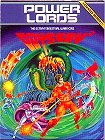 The Game: As superhero Adam Power, you’re the pilot of a space sled on patrol around the explosive Volcan Rock, an active volcano which frequently blows its top. And what better cover for the bad guys? Gryptogg, Raygoth and Arkus are perfecting their evil plans for a “gravitational ray” which basically amounts to a portable black hole – its gravity can alter the course of your space sled if you’re on a direct horizontal line-of-sight with it. Add to that meteors pummeling the ground from space and the enormous laser-eyed space serpent, and you’ve got your hands full just staying alive, let alone battling evil. (North American Philips, 1983)
The Game: As superhero Adam Power, you’re the pilot of a space sled on patrol around the explosive Volcan Rock, an active volcano which frequently blows its top. And what better cover for the bad guys? Gryptogg, Raygoth and Arkus are perfecting their evil plans for a “gravitational ray” which basically amounts to a portable black hole – its gravity can alter the course of your space sled if you’re on a direct horizontal line-of-sight with it. Add to that meteors pummeling the ground from space and the enormous laser-eyed space serpent, and you’ve got your hands full just staying alive, let alone battling evil. (North American Philips, 1983)
Memories: So, friends, it all comes down to this – the last Odyssey2 game ever to hit the store shelves in the United States – and to tell you the truth, it’s a doozie. Power Lords is everything I ask for in a classic video game – a real numb-thumb, sweaty-palms experience that doesn’t let up.
Popeye
 The Game: Well, blow me down! Popeye the sailor man gets his own video game. As Popeye, you’re trying to catch Olive Oyl’s falling hearts before they descend to sea level and are lost, while ducking Bluto’s punches at the same time. A can of spinach appears every so often, giving you the opportunity to read the big bully the riot act (comic strip-style, of course). (Parker Brothers, 1983)
The Game: Well, blow me down! Popeye the sailor man gets his own video game. As Popeye, you’re trying to catch Olive Oyl’s falling hearts before they descend to sea level and are lost, while ducking Bluto’s punches at the same time. A can of spinach appears every so often, giving you the opportunity to read the big bully the riot act (comic strip-style, of course). (Parker Brothers, 1983)
Memories: Well, shiver me timbers! It took me just shy of twenty years to get it, mateys, but this old landlubber has finally gotten his mitts on Popeye for the Odyssey2 – and blow me down, it’s seaworthy!
Plaque Attack

 The Game: One of the great dental scare games (also see Tooth Protectors and Jawbreaker), Plaque Attack pits you against tooth decay itself! Wave after wave of burgers, hot dogs, fries ‘n’ fruit assault a mouth with eight teeth in it (only eight? Something tells me this patient’s beyond help already), and you pilot a tube of toothpaste packing enough fluoride to blast them all into sparkly white oblivion – if you can keep up with all of them. (Activision, 1983)
The Game: One of the great dental scare games (also see Tooth Protectors and Jawbreaker), Plaque Attack pits you against tooth decay itself! Wave after wave of burgers, hot dogs, fries ‘n’ fruit assault a mouth with eight teeth in it (only eight? Something tells me this patient’s beyond help already), and you pilot a tube of toothpaste packing enough fluoride to blast them all into sparkly white oblivion – if you can keep up with all of them. (Activision, 1983)
Memories: It’s a weird topic for a game, but truth be told, that’s one of the many things I loved about the early era of video games: it wasn’t all fighting, driving, first-person shooter, RPG, flight sim or dancing. Anything was game (to coin a phrase). Now, in all honesty, Plaque Attack is little more than a rehash of Megamania (right down to the killer burgers) with a dash of Missile Command thrown in for good measure (if you’re doing well and survive a wave where you’ve lost teeth, you’ll actually get a tooth back).
Pick Axe Pete
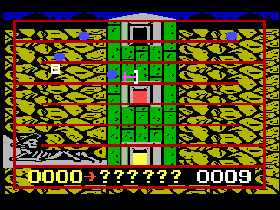 The Game: As Pete, you start out in the center of a multi-tiered mine – not at the bottom – and your boulder-smashing pick axe begins to deteriorate after about one minute. Then you either have to jump over or duck under the onslaught of falling rocks, or you’re toast. Falling to the lower levels won’t kill you, if you time it just right so as not to land right in the middle of an avalanche. When two boulders collide, they can uncover treasures such as a fresh pick axe or, more importantly, a key to the next level. (N.A.P., 1983)
The Game: As Pete, you start out in the center of a multi-tiered mine – not at the bottom – and your boulder-smashing pick axe begins to deteriorate after about one minute. Then you either have to jump over or duck under the onslaught of falling rocks, or you’re toast. Falling to the lower levels won’t kill you, if you time it just right so as not to land right in the middle of an avalanche. When two boulders collide, they can uncover treasures such as a fresh pick axe or, more importantly, a key to the next level. (N.A.P., 1983)
Memories: Released in Europe only for the Videopac G7400 – the European hardware equivalent of the Odyssey3 – Pick Axe Pete is a good barometer of how the classic Odyssey2 games would’ve been “enhanced” for the ultimately unreleased Odyssey3. And when I say “enhanced”, I mean that very loosely. On the plus side: the game is untouched in and of itself, which is a good starting point. (I think I’ve made clear that I consider Pete the pinnacle of gaming on the O2.)
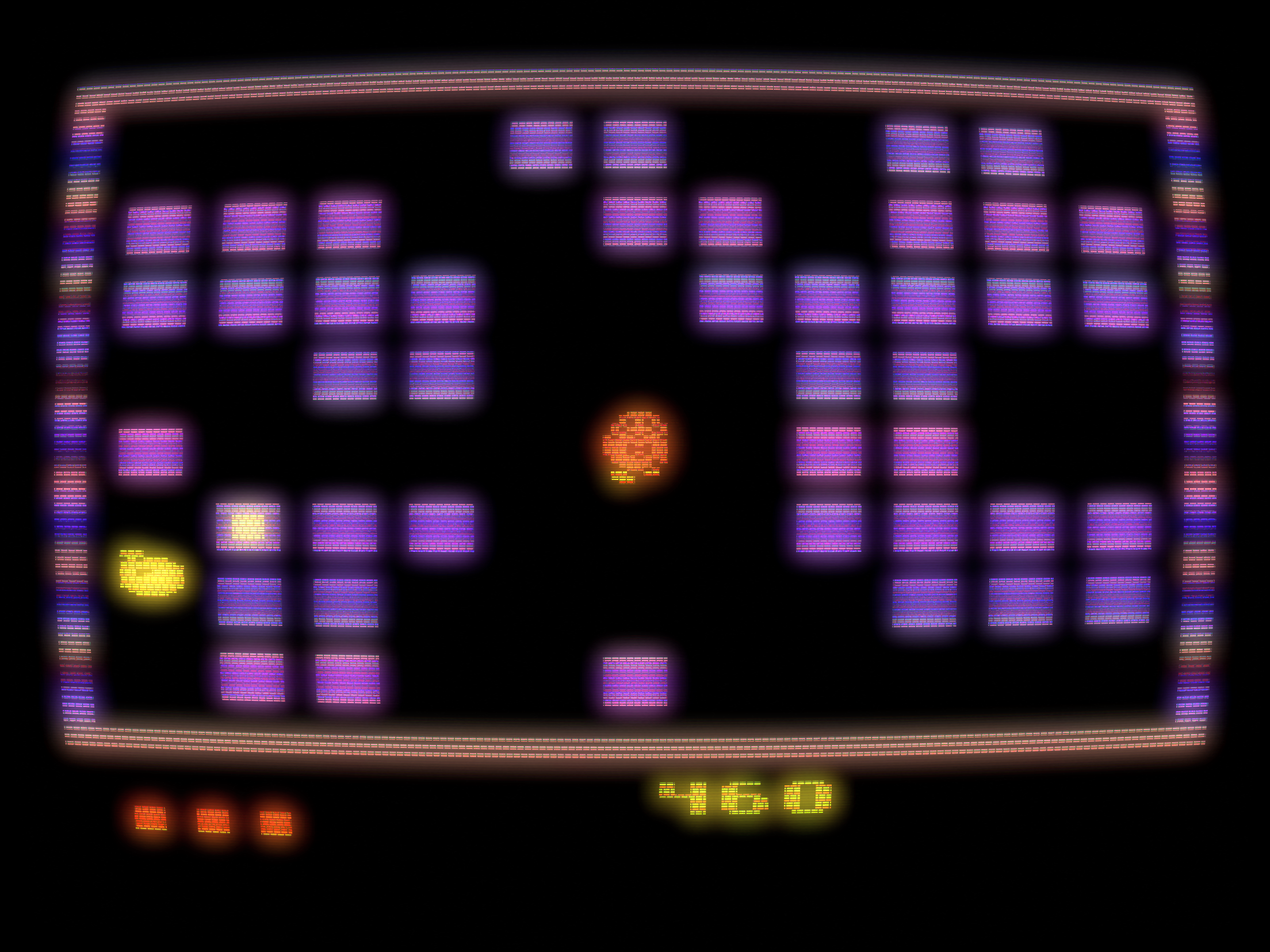
Pengo
 The Game: As a cute, fuzzy, harmless little penguin, you roam around an enclosed maze of ice blocks. If this sounds too good to be true – especially for a polar-dwelling avian life form – that’s because you’re not the only critter waddling around in the frozen tundra. Killer Sno-Bees chase little Pengo around the ice, and if they catch up to him and sting him, it’ll cost you a life. But your little flightless waterfowl isn’t completely defenseless. Pengo can push blocks of ice out of the maze, changing the configuration of the playing field and squashing Sno-Bees with a well-timed shove. Clearing the field of Sno-Bees allows you to advance to the next level. (Atari, 1983)
The Game: As a cute, fuzzy, harmless little penguin, you roam around an enclosed maze of ice blocks. If this sounds too good to be true – especially for a polar-dwelling avian life form – that’s because you’re not the only critter waddling around in the frozen tundra. Killer Sno-Bees chase little Pengo around the ice, and if they catch up to him and sting him, it’ll cost you a life. But your little flightless waterfowl isn’t completely defenseless. Pengo can push blocks of ice out of the maze, changing the configuration of the playing field and squashing Sno-Bees with a well-timed shove. Clearing the field of Sno-Bees allows you to advance to the next level. (Atari, 1983)
Memories: One of the last Sega games to be released by a manufacturer other than Sega itself, the 2600 edition of Sega’s cutesy coin-op is pretty to look at sometimes, but doesn’t offer much in the way of game play.
Pac-Man
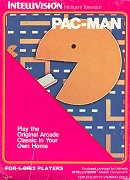 The Game: As a round yellow creature consisting of a mouth and nothing else, you maneuver around a relatively simple maze, gobbling small dots and evading four colorful monsters who can eat you on contact. In four corners of the screen, large flashing dots enable you to turn the tables and eat the monsters for a brief period for an escalating score . Periodically, assorted items appear near the center of the maze, and you can consume these for additional points as well. The monsters, once eaten, return to their home base in ghost form and return to chase you anew. If cleared of dots, the maze refills and the game starts again, but just a little bit faster… (Atarisoft, 1983; re-released by INTV Corp., 1984)
The Game: As a round yellow creature consisting of a mouth and nothing else, you maneuver around a relatively simple maze, gobbling small dots and evading four colorful monsters who can eat you on contact. In four corners of the screen, large flashing dots enable you to turn the tables and eat the monsters for a brief period for an escalating score . Periodically, assorted items appear near the center of the maze, and you can consume these for additional points as well. The monsters, once eaten, return to their home base in ghost form and return to chase you anew. If cleared of dots, the maze refills and the game starts again, but just a little bit faster… (Atarisoft, 1983; re-released by INTV Corp., 1984)
Memories: This version of the world’s most famous coin-op does not disappoint. It’s a little surprising that Atari could do a better Pac-Man for the Intellivision than it could for the VCS. And, not to insult Mr. Tod Frye, who programmed the 2600 version of Pac-Man, but the programmer of Atarisoft’s Intellivision translation of the game was someone who had previously worked for Mattel Electronics itself, and knew how to milk the most out of the machine’s graphics and sound capabilities. And what a difference it made!
Oink!
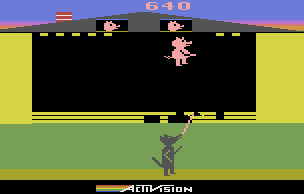
 The Game: As one of the Three Little Pigs, your job is to make sure the bricks of your porcine pals’ dwelling is strong enough to withstand the assault of the Big Bad Wolf, whose tongue resembles that of some kind of poisonous frog (if he knocks a big enough hole in the pigs’ brick wall, he can fire his tongue through the opening and “sting” your pig…!?). The game continues until you repair the wall…or run out of little pigs. (Activision, 1983)
The Game: As one of the Three Little Pigs, your job is to make sure the bricks of your porcine pals’ dwelling is strong enough to withstand the assault of the Big Bad Wolf, whose tongue resembles that of some kind of poisonous frog (if he knocks a big enough hole in the pigs’ brick wall, he can fire his tongue through the opening and “sting” your pig…!?). The game continues until you repair the wall…or run out of little pigs. (Activision, 1983)
Memories: This amusing little gem from Activision seems to borrow a little bit from Taito‘s Zoo Keeper coin-op, in which one controls the zoo guru in question, trying to make sure that wild critters such as snakes and elephants stay bricked into their cages. At least the same basic game concepts seem to be shared.
Oink! is a hysterical little game whose deceptively cutesy  characters may have caught more than one player off guard – the game soon achieves a frantic pace. The three little pigs/big bad wolf elements are also present in Konami‘s Pooyan, in which Mama Pig fights back (and boy, does she look pissed!).
characters may have caught more than one player off guard – the game soon achieves a frantic pace. The three little pigs/big bad wolf elements are also present in Konami‘s Pooyan, in which Mama Pig fights back (and boy, does she look pissed!).
No Escape!
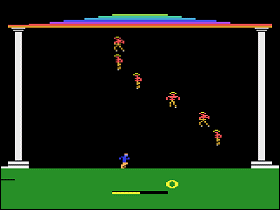 The Game: Jason, having made off with the Golden Fleece, has enraged the gods, who trap him in a temple along with a never-ending supply of Furies. Players can move Jason from side to side to avoid the Furies’ fire, and to fire back – but shooting a Fury directly will create another Fury rather than destroying it. Carefully-timed shots at the temple’s roof, however, will dislodge bricks that can permanently eliminate any Furies that they hit. Jason (and, presumably, countless screaming Argonauts) will advance a level when all of the Furies on the present level are destroyed. Taking too much damage from the Furies (or from chunks of the roof that he himself has caused to fall) will cost Jason his life. (Imagic, 1983)
The Game: Jason, having made off with the Golden Fleece, has enraged the gods, who trap him in a temple along with a never-ending supply of Furies. Players can move Jason from side to side to avoid the Furies’ fire, and to fire back – but shooting a Fury directly will create another Fury rather than destroying it. Carefully-timed shots at the temple’s roof, however, will dislodge bricks that can permanently eliminate any Furies that they hit. Jason (and, presumably, countless screaming Argonauts) will advance a level when all of the Furies on the present level are destroyed. Taking too much damage from the Furies (or from chunks of the roof that he himself has caused to fall) will cost Jason his life. (Imagic, 1983)
Memories: One of the lesser-known Imagic titles for the 2600, No Escape! was titled Escape From Argos for much of its development cycle. It combines the tried-and-true elements of slide-and-shoot games and brick-busting games such as Breakout, but does it in such a novel way that it manages to be fresh.
Nova Blast
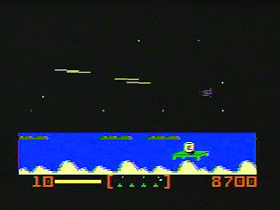 The Game: You’re the pilot of a fighter plane whose job is to patrol the sky at supersonic speeds and eliminate alien threats to the cities on the ground below You have a radar screen spanning the entire globe at your disposal, and endless arsenals of weaponry. If all of the cities are wiped out, your mission – and your life as you know it – are over. (Imagic, 1983)
The Game: You’re the pilot of a fighter plane whose job is to patrol the sky at supersonic speeds and eliminate alien threats to the cities on the ground below You have a radar screen spanning the entire globe at your disposal, and endless arsenals of weaponry. If all of the cities are wiped out, your mission – and your life as you know it – are over. (Imagic, 1983)
Memories: Imagic had done a much better job bringing Donkey Kong to the Intellivision than Coleco did, with Beauty And The Beast being almost incalculably better than Coleco’s official Kong port. So why not do the same for Defender?
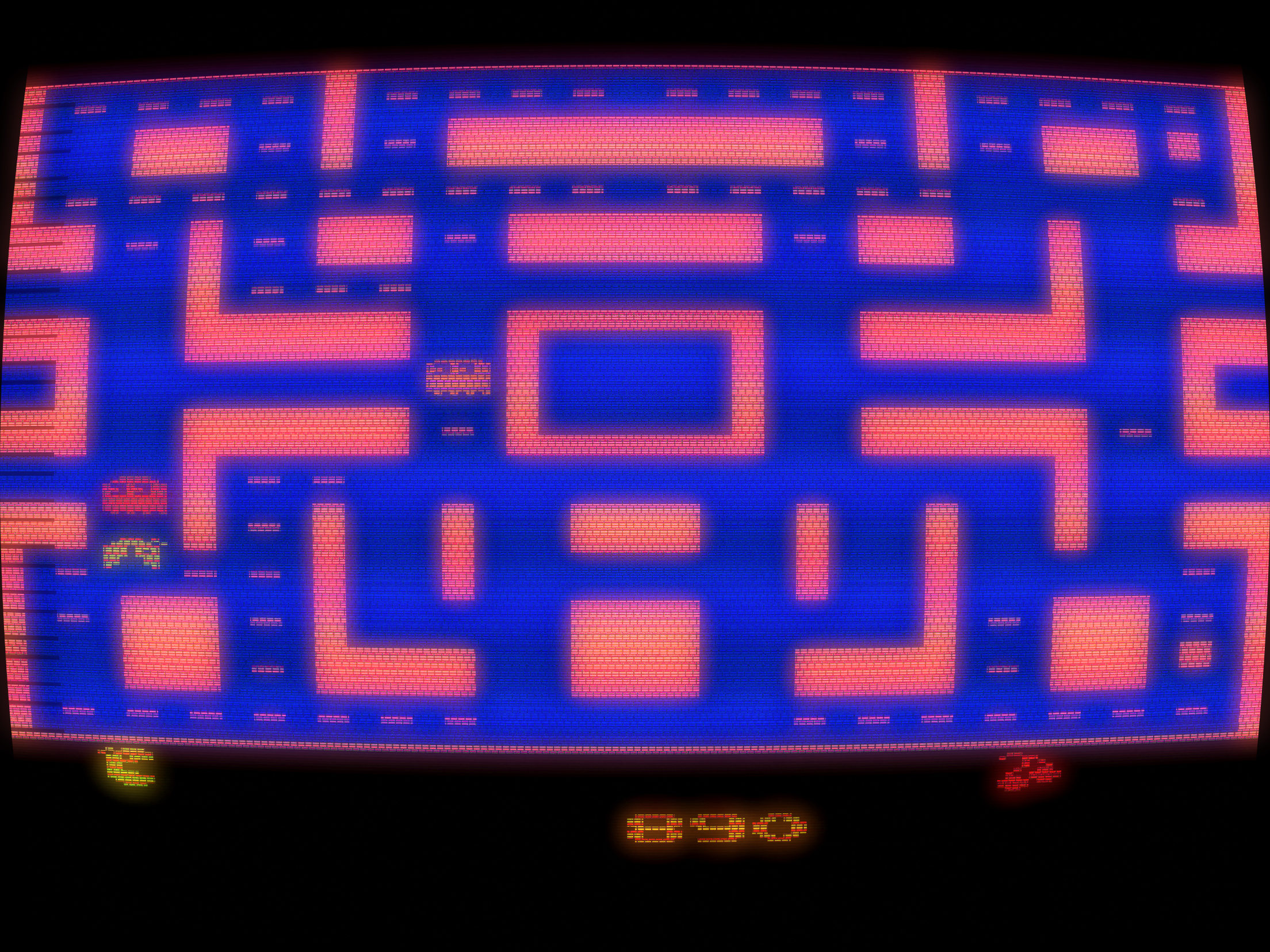
Ms. Pac-Man
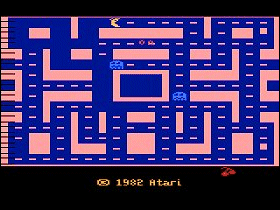 The Game: As the bride of that most famous of single-celled omniphage life forms, your job is pretty simple – eat all the dots, gulp the large blinking dots in each corner of the screen and eat the monsters while they’re blue, and avoid
The Game: As the bride of that most famous of single-celled omniphage life forms, your job is pretty simple – eat all the dots, gulp the large blinking dots in each corner of the screen and eat the monsters while they’re blue, and avoid  the monsters the rest of the time. Occasionally various fruits and other foods will bounce through the maze, and you can gobble those for extra points. (Atari, 1983)
the monsters the rest of the time. Occasionally various fruits and other foods will bounce through the maze, and you can gobble those for extra points. (Atari, 1983)
Memories: Some people were surprised when, after the stunning success of the Ms. Pac-Man arcade game, Atari announced that it would be bringing the latest member of the Pac-family home. After how the first game had turned out, why bother?
Ms. Pac-Man
 The Game: As the bride of that most famous of single-celled omniphage life forms, your job is pretty simple – eat all the dots, gulp the large blinking dots in each corner of the screen and eat the monsters while they’re blue, and avoid the monsters the rest of the time. Occasionally various fruits and other foods will bounce through the maze, and you can gobble those for extra points. (Atari, 1983)
The Game: As the bride of that most famous of single-celled omniphage life forms, your job is pretty simple – eat all the dots, gulp the large blinking dots in each corner of the screen and eat the monsters while they’re blue, and avoid the monsters the rest of the time. Occasionally various fruits and other foods will bounce through the maze, and you can gobble those for extra points. (Atari, 1983)
Memories: Oh boy. If there’s a genre of video game that suffers most pathetically at the hands of Atari’s non-centering 5200 controllers, it’s the maze game. And Ms. Pac-Man is among the worst victims of the 5200’s joysticks: you could wind up smacking into a wall, unable to move before those three ghosts nailed you from behind. (Actually, that sounds pretty bad.)

Mr. Do’s Castle
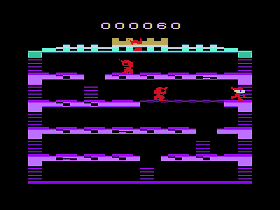 The Game: As cuddly clown Mr. Do, you’re scrambling to squish all the unicorns who are invading your castle. You can repel them momentarily with your clown hammer, but you can only squish them permanently by knocking a brick out from the floor above. Most bricks contain cherries, but some also contain keys that unlock the door at the top. When that door is completely unlocked, touching it will transform the unicorns into walking plus signs; if you hammer five of them and spell the word EXTRA, you get an extra “life.” Clearing the screen of monsters or cherries advances you to the next level. (Parker Brothers., 1983)
The Game: As cuddly clown Mr. Do, you’re scrambling to squish all the unicorns who are invading your castle. You can repel them momentarily with your clown hammer, but you can only squish them permanently by knocking a brick out from the floor above. Most bricks contain cherries, but some also contain keys that unlock the door at the top. When that door is completely unlocked, touching it will transform the unicorns into walking plus signs; if you hammer five of them and spell the word EXTRA, you get an extra “life.” Clearing the screen of monsters or cherries advances you to the next level. (Parker Brothers., 1983)
Memories: I loved Mr. Do’s Castle in the arcade, and at the time I loved it on the VCS as well, though with the benefit of hindsight, I don’t think the home version was as definitive as I once thought it was.
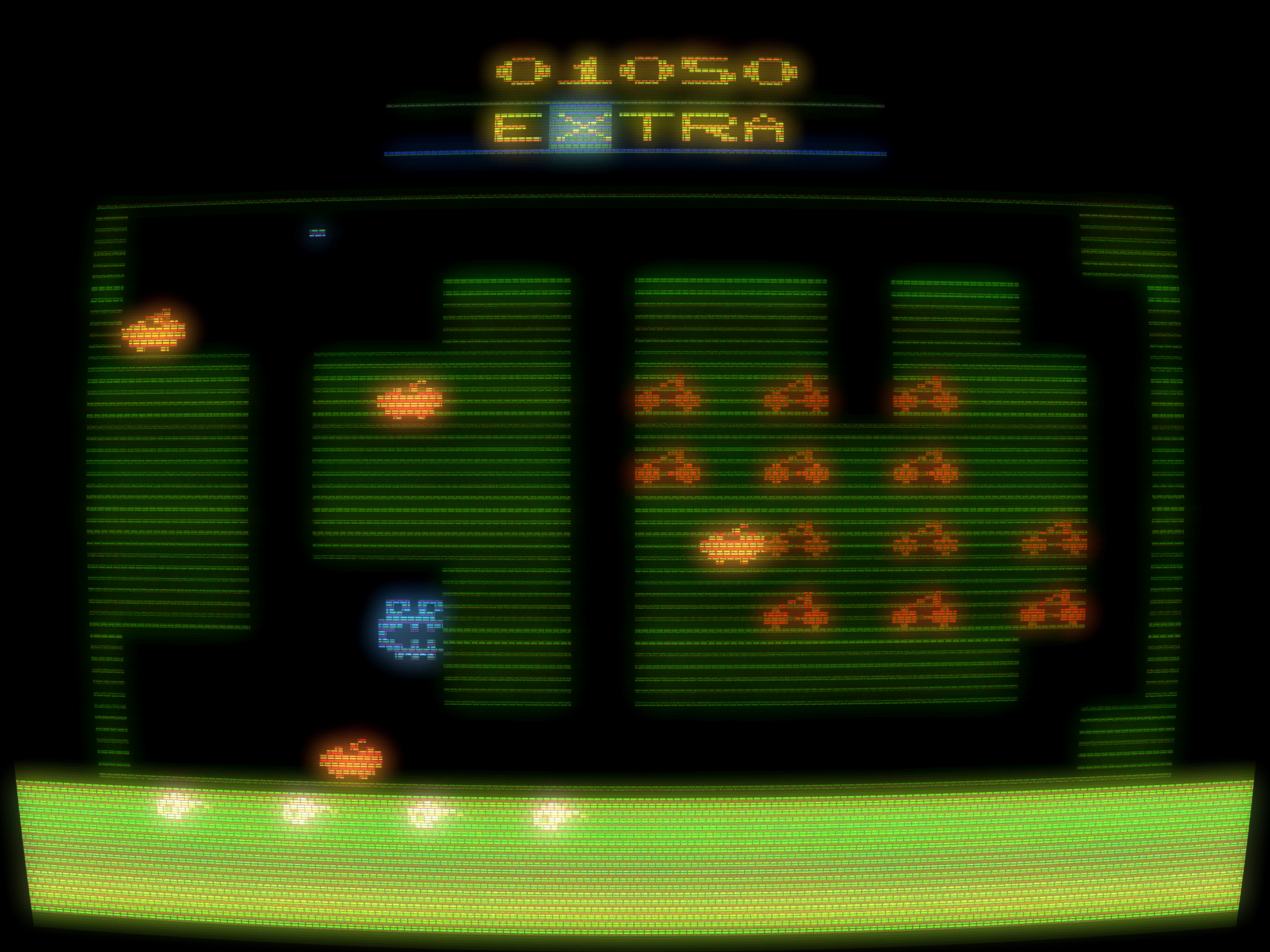
Mr. Do!
 The Game: As an elfin dweller of a magic garden, you must avoid or do away with a bunch of nasty critters who are after you, while gobbling up as much yummy fruit as you can. (Coleco, 1983)
The Game: As an elfin dweller of a magic garden, you must avoid or do away with a bunch of nasty critters who are after you, while gobbling up as much yummy fruit as you can. (Coleco, 1983)
Memories: Not the hardest game in the world to translate for home console systems, Mr. Do! is a mixed bag on the 2600. Coleco took a decent swipe at bringing Mr. Do! to the most prolific console of its day, but the problem with this game is that, all the way back to the arcade, there was always another game to which it could be compared: Dig Dug.
Moonsweeper
 The Game: As the pilot of a super-fast intergalactic rescue ship (which is also armed to the teeth, which explains the absence of a red cross painted on the hull), you must navigate your way through hazardous comets and space debris, entering low orbit around various planets from which you must rescue a certain number of stranded civilians. But there’s a reason you’re armed – some alien thugs mean to keep those people stranded, and will do their best to blast you into dust. You can return the favor, and after you rescue the needed quota of people from the surface, you must align your ship with a series of launch rings to reach orbit again. (Imagic, 1983)
The Game: As the pilot of a super-fast intergalactic rescue ship (which is also armed to the teeth, which explains the absence of a red cross painted on the hull), you must navigate your way through hazardous comets and space debris, entering low orbit around various planets from which you must rescue a certain number of stranded civilians. But there’s a reason you’re armed – some alien thugs mean to keep those people stranded, and will do their best to blast you into dust. You can return the favor, and after you rescue the needed quota of people from the surface, you must align your ship with a series of launch rings to reach orbit again. (Imagic, 1983)
Memories: Not terribly different from the Atari 2600 edition of the same game, Colecovision Moonsweeper gets a big graphical boost from the step up to the most powerful console of the early 80s.
Moon Patrol
 The Game: Driving an agile, armed moon buggy across the lunar surface, you must jump over craters and land mines, shoot large boulders (some occasionally mobile) out of your way, and try not to be on the receiving end of hostile fire from alien ships that try to strafe you. Some of the ships, which look very suspiciously like the triangle-of-spheres enemy ships from Gyruss, can even bomb the moon and make new craters for you to jump over – which may put you right into their line of fire.
The Game: Driving an agile, armed moon buggy across the lunar surface, you must jump over craters and land mines, shoot large boulders (some occasionally mobile) out of your way, and try not to be on the receiving end of hostile fire from alien ships that try to strafe you. Some of the ships, which look very suspiciously like the triangle-of-spheres enemy ships from Gyruss, can even bomb the moon and make new craters for you to jump over – which may put you right into their line of fire.
Later on, you also get to blast away tanks and dodge pesky jet cars which “tailgate” and then try to ram you. (Atari, 1983)
Memories: This was a game that I played the hell out of as a kid – I’m stunned that all the bits didn’t fall out of the cartridge from repeated use. Granted, Moon Patrol in the arcade was a feast for the eyes and ears, and it’d be foolish to expect none of that to be lost in the translation to a far simpler hardware platform like the Atari 2600. But what’s surprising is how much of the game actually survived the transition.

Mario Bros.
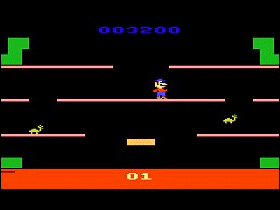 The Game: As Mario (or Luigi, if you’re playing with a second person), you’re trying to rid the sewers of such pests as evil lobsters and turtles. Try to grab as many coins as you can (it’s amazing what people let fall down the drain and into the sewer system sometimes), and always be on the lookout for the fireballs which bounce from level to level. Just how did all these things get into the sewers, anyway? (Atari, 1983)
The Game: As Mario (or Luigi, if you’re playing with a second person), you’re trying to rid the sewers of such pests as evil lobsters and turtles. Try to grab as many coins as you can (it’s amazing what people let fall down the drain and into the sewer system sometimes), and always be on the lookout for the fireballs which bounce from level to level. Just how did all these things get into the sewers, anyway? (Atari, 1983)
Memories: Atari snatched the home video game license for Mario Bros. and proved that it could successfully port the game to the Atari 2600, as if to thumb its nose at Coleco for the mediocre (and that’s being charitable) 2600 version of Donkey Kong Jr.. Mario Bros. turned out to be one of the better Atari arcade adaptations.
M*A*S*H
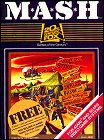 The Game: In a bizarre collision of two very different game play elements that would probably be considered minigames today, you’re a fearless helicopter rescue pilot for the 4077th, fishing wounded U.S. soldiers out of harm’s way during the Korean War. When the window of your helicopter no longer shows up as hollow, you’ve got a full load and must safety return the wounded to the M*A*S*H base, and then go to retrieve more wounded. An enemy tank scoots along the bottom of the screen, trying to down both your helicopter and a computer-controlled chopper or an opponent’s chopper. This does not help matters, although being shot down merely causes a delay as an emergency vehicle appears – miraculously impervious to enemy fire – to push the wreckage off the screen before a new helicopter appears. Every so often, the action suddenly switches to the operating table, where you have to retrieve projectiles from victims’ bodies without causing worse damage as you remove them, and with the clock ticking down – if you fail to complete the surgery in time, then it’s goodbye, farewell and amen to that patient. (Think of the board game Operation! here and you’ve got the idea.) (20th Century Fox Games Of The Century, 1983)
The Game: In a bizarre collision of two very different game play elements that would probably be considered minigames today, you’re a fearless helicopter rescue pilot for the 4077th, fishing wounded U.S. soldiers out of harm’s way during the Korean War. When the window of your helicopter no longer shows up as hollow, you’ve got a full load and must safety return the wounded to the M*A*S*H base, and then go to retrieve more wounded. An enemy tank scoots along the bottom of the screen, trying to down both your helicopter and a computer-controlled chopper or an opponent’s chopper. This does not help matters, although being shot down merely causes a delay as an emergency vehicle appears – miraculously impervious to enemy fire – to push the wreckage off the screen before a new helicopter appears. Every so often, the action suddenly switches to the operating table, where you have to retrieve projectiles from victims’ bodies without causing worse damage as you remove them, and with the clock ticking down – if you fail to complete the surgery in time, then it’s goodbye, farewell and amen to that patient. (Think of the board game Operation! here and you’ve got the idea.) (20th Century Fox Games Of The Century, 1983)
Memories: M*A*S*H could be held up as a prime example of the third party video game market right before the Crash, being two very simple (and not terribly original) games squashed together with a licensed title. But let’s give it credit for being better than, say, Chase The Chuckwagon – M*A*S*H is at least fun.
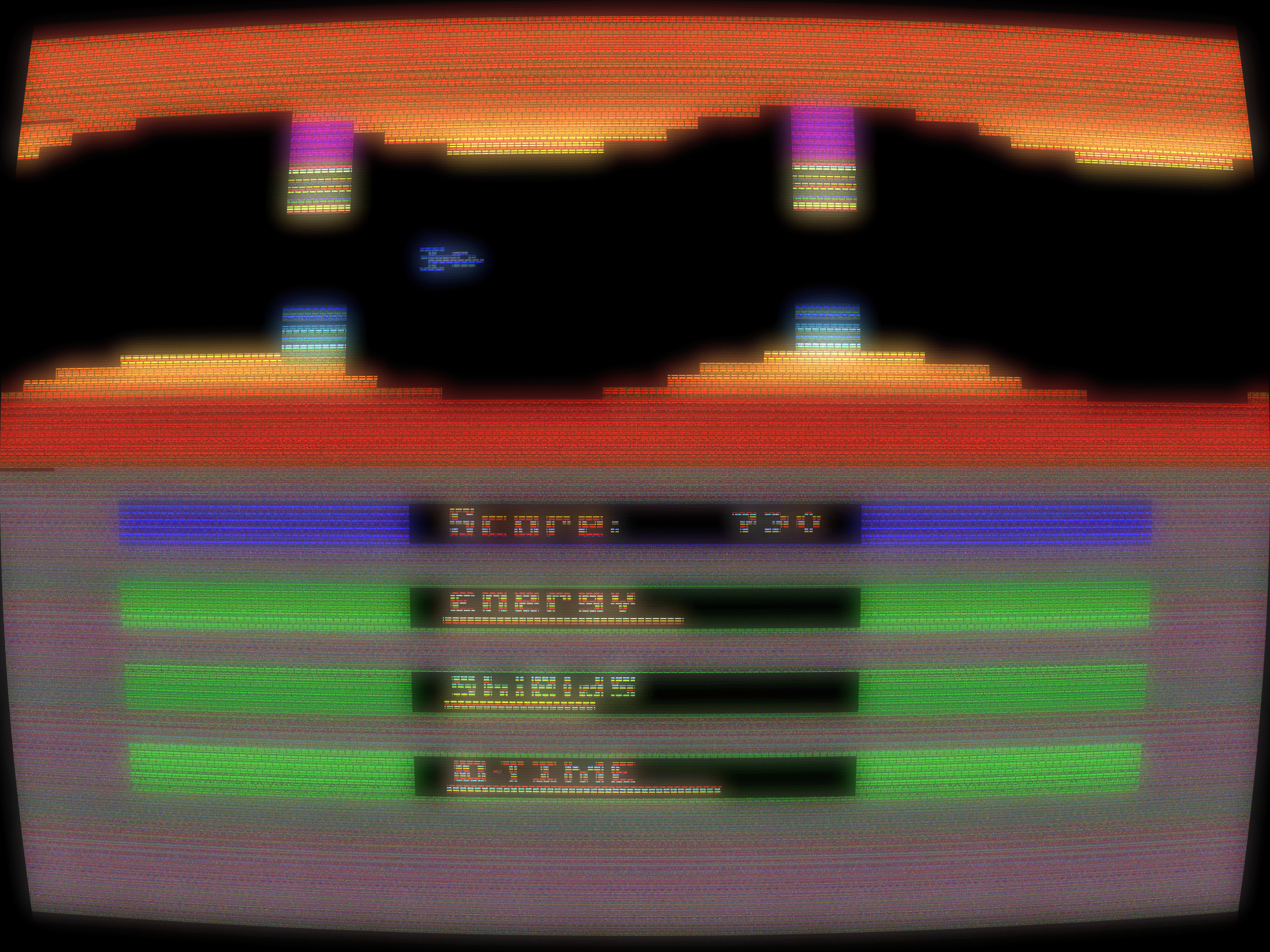
Laser Gates
 The Game: You’re piloting the Dante Dart through the innards of an enormous sentient computer. The computer was originally constructed to defend the galaxy, but now it’s gone haywire and is planning to destroy the galaxy instead. There’s only one problem with such a massive defense computer: its own internal defense mechanisms. Blast through densepack columns and laser gates as they try to fry your ship, and watch out for laser turrets, “byte bats” and other menaces which will pursue you. Your Energy meter is depleted by constant firing, so make every shot count. And your Shield meter drops as you take hits from enemy fire or crash through the defenses with your ship – something you don’t want to do too much of, lest your mission end prematurely and fatally. (Imagic, 1983)
The Game: You’re piloting the Dante Dart through the innards of an enormous sentient computer. The computer was originally constructed to defend the galaxy, but now it’s gone haywire and is planning to destroy the galaxy instead. There’s only one problem with such a massive defense computer: its own internal defense mechanisms. Blast through densepack columns and laser gates as they try to fry your ship, and watch out for laser turrets, “byte bats” and other menaces which will pursue you. Your Energy meter is depleted by constant firing, so make every shot count. And your Shield meter drops as you take hits from enemy fire or crash through the defenses with your ship – something you don’t want to do too much of, lest your mission end prematurely and fatally. (Imagic, 1983)
Memories: The scrolling sub-genre of flying through an enclosed space is hardly anything new for the 2600 (witness Atari’s own decent Vanguard translation, Super Cobra, Fantastic Voyage, etc.), but Laser Gates takes this task from a raw “try-not-to-get-killed” level to a puzzle of resource management and timing. Huge stretches of this game will go by where you don’t need to fire a single shot or do a lot of moving around.
Killer Bees!
 The Game: You control a solitary swarm of “good” bees, trailed by a couple of handy ray guns on the same vertical axis. The game starts out with a bunch of dim-witted Beebots bumbling around the screen, which you can sting with your bee swarm until the ‘bots slow down and finally expire, marked by a rather grim little tombstone! This probably sounds easy enough, but there are killer bees from outer space emerging from hives around the edge of the play area, and when their swarms collide with your swarm, you lose bees. The only defense against the killer bees is a pair of ray guns, which have to recharge after every use. (North American Philips, 1983)
The Game: You control a solitary swarm of “good” bees, trailed by a couple of handy ray guns on the same vertical axis. The game starts out with a bunch of dim-witted Beebots bumbling around the screen, which you can sting with your bee swarm until the ‘bots slow down and finally expire, marked by a rather grim little tombstone! This probably sounds easy enough, but there are killer bees from outer space emerging from hives around the edge of the play area, and when their swarms collide with your swarm, you lose bees. The only defense against the killer bees is a pair of ray guns, which have to recharge after every use. (North American Philips, 1983)
Memories: This is one of the strangest and most unique games that was ever made for the Odyssey2. As the Odyssey programmers realized very quickly, the Voice was very limited, and Killer Bees! saw some interesting innovations in that area, namely the “bee buzz” generated by the speech module. Programmer Bob Harris has said that Killer Bees! was his attempt to bring the relentless momentum of Centipede to the Odyssey2, though players might never have made that connection apart from the insectoid theme. It’s a damned aggravating and addictive little game!
 using WordPress and
using WordPress and